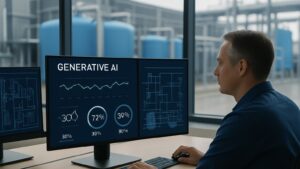The goal of operational excellence and efficiency has emerged as a key concern as data centers change. The requirement for efficient simulation and testing environments has grown. This is because these mission-critical facilities get larger and more sophisticated. This is the point at which digital twins and virtualization combine to create something compelling. It has the enormous potential to transform data center planning, operation, and maintenance completely. Moreover, these state-of-the-art technologies enable unparalleled capabilities. This is for simulation, testing, and optimization without affecting live operations. It is done by generating virtual duplicates of actual data center environments and assets. In this article, we will look at how digital twins and virtualization can enhance data center simulation and testing.
The Digital Twin Revolution
Digital twins, often known as virtual copies of real assets or systems, are becoming more and more popular in a variety of sectors, including data centers.
What are Digital Twins?
A virtual model that faithfully imitates the traits, actions, and functionality of a real asset is called a digital twin. It is a dynamic, data-driven representation. It changes and updates constantly during the physical counterpart’s lifetime. Furthermore, digital twins provide a detailed virtual duplicate. It replicates the status and functionality of the physical item. This is done by using data from sensors, historical records, and real-time input.
Digital twins can represent particular parts of data centers. It includes servers, cooling systems, or power distribution units. It also includes whole buildings or even data center ecosystems with several sites. These virtual models can be utilized for several tasks without interfering with ongoing operations. This includes optimization, simulation, predictive maintenance, and what-if scenarios.
Virtualization: The Enabler of Flexible Environments
Technologies for virtualization have long been important for improving resource usage and data center efficiency.
The Power of Virtualization
The process of virtualization entails separating networking, storage, and server infrastructure from the underlying physical hardware. This concept enables the creation of virtual machines (VMs) and containerized environments with ease of provisioning, scaling, and management on demand. It has completely transformed data centers through virtualization. It has made it possible to consolidate servers, balance workloads, and allocate resources efficiently. Moreover, these changes have also increased operational agility and considerably reduced costs.
Virtualization is important because it enables the creation of virtual replicas of data center systems and components by providing the necessary environment and infrastructure. It is important for data center simulation and testing. Additionally, data center managers can build virtual environments that closely resemble the complexity and size of their physical counterparts. As a result, it allows for thorough testing and simulations. This is one of the major virtualization benefits to the data center.
Combining Digital Twins and Virtualization for Data Center Simulation
Numerous opportunities for data center testing and simulation are made possible by the interaction of virtualization technologies with digital twins.
Enabling Comprehensive Simulations
Data center operators can create very realistic and thorough simulations of their complete data center ecosystem. This is by merging digital twins with virtualized environments. A wide range of components, including their interdependencies and linkages, can be included in these simulations. It includes servers, storage systems, networking infrastructure, cooling systems, and also power distribution units.
Virtualized environments offer the infrastructure and processing power required to conduct these simulations on a large scale. Meanwhile, digital twins offer a virtualized version of the actual assets. Data center operators can conduct extensive simulations and analyze intricate scenarios. They can also investigate “what-if” scenarios with this potent combo. Moreover, all of this can be done without having to worry about interfering with ongoing business operations.
Facilitating Testing and Experimentation
Combining virtualization with digital twins offers the capacity to carry out intensive testing and experimentation safely and effectively. Moreover, data center managers can try out the effects of different upgrades, modifications, or new technologies. This is on virtual copies of their environments without affecting the real production systems.
When performing software updates, hardware deployments, or configuration changes in a physical data center, operators can first evaluate the consequences of such changes on the virtual environment. Ultimately, this strategy improves data center uptime and dependability. This is by reducing the chance of unanticipated problems, service interruptions, and downtime.
Optimizing Data Center Operations
The combination of virtualization and digital twins can greatly assist in optimizing data center operations. Furthermore, data center operators can pinpoint areas for development. They can also optimize resource allocation, and fine-tune operating procedures. It can be done by utilizing the rich data and insights that come from simulations and virtual testing environments.
For example, inside the infrastructure of the data center, simulations can assist in locating any bottlenecks, inefficiencies, or capacity restrictions. So, with this information at hand, operators can execute preventative measures. They can also put load-balancing plans into place, or schedule capacity increases. This can be done before challenges in the physical environment develop.
Enhancing Resilience and Business Continuity
Reliability and business continuity are crucial for data centers, which are vital pieces of infrastructure. Virtualization and digital twins work together to enable thorough disaster recovery planning and testing.
Operators can resemble a variety of catastrophe situations. This includes power outages, cyberattacks, and natural disasters. This is by building virtual copies of their data center settings. These simulations can uncover possible weaknesses. Furthermore, organizations can assess the efficacy of current disaster recovery plans and improve recovery tactics.
Additionally, virtualized environments can serve as makeshift infrastructure in real-world catastrophe scenarios. Consequently, they enable data center operations to continue as usual with minimal interruption while repairing or restoring the physical infrastructure.
Digital Twins and Virtualization: Challenges and Considerations
The combination of digital twins and virtualization presents a wealth of opportunities for data center testing and simulation. However. several issues must be taken into account.
Data Quality and Accuracy
The accuracy and quality of the underlying data have a major impact on how well digital twins and virtualized environments work. Realistic virtual representations of actual assets and systems require precise and current data collected from a variety of sources. It includes sensors, logs, and monitoring systems.
Data center operators must undertake strong data management methods. It maintains the quality and dependability of the data streaming into digital twins and virtualized environments. This includes data cleansing, normalization, and validation procedures.
Computational Resources and Scalability
Complex data center environment simulation can be computationally demanding. This is particularly true when large-scale facilities or multi-site ecosystems are involved. So, it is imperative to guarantee a enough amount of computing resources. It includes memory, storage, and processing power, to execute virtualized environments and simulations smoothly.
The computing needs of these simulations can require data center operators to make investments in specialized infrastructure. Furthermore, scalability becomes an even more important factor to take into account. This is as the simulated environments get more complicated and expansive over time.
Integration and Interoperability
It might be difficult to integrate digital twins and virtualization technologies with the current data center management systems. Moreover, there can be incapacity in monitoring tools and other operational software. Simplifying data flows, facilitating centralized management, and optimizing the advantages of simulation and testing environments all depend on the smooth integration and interoperability of these diverse components.
Data center operators need to make sure that the digital twins and virtualization solutions they have selected are compatible with their current technology stack. They also need to plan for any necessary customizations or modifications.
Skills and Training
It can take certain knowledge and abilities to implement and use both technologies for testing and simulation. Employees working in data centers can require training to comprehend the nuances of these technologies. They also need it to analyze simulation results, and make the most use of the knowledge acquired from virtual environments.
Data center operators should fund training programs and knowledge transfer activities. They should also recruit or work with professionals in these fields. It ensures the successful adoption and utilization of digital twins and virtualization.
Conclusion
Digital twins and virtualization tech boost data center simulation and testing. They create virtual copies of real assets for thorough testing and optimization. This helps operators improve operations and resilience without disrupting live systems. Overcoming challenges like data quality and skills is key to success.
Adopting these technologies in data centers is crucial for efficiency. To know all about efficiency in data centers, join the Energy Efficiency for Data Centers Summit on May 16-17, 2024, in Dallas TX, USA. Gain insights from experts, learn best practices, and stay ahead in this field.
This summit is essential for data center professionals aiming to enhance efficiency and sustainability while reducing energy costs and emissions. Don’t miss out on expert talks, panel discussions, and networking opportunities to excel in energy-efficient data center operations.





